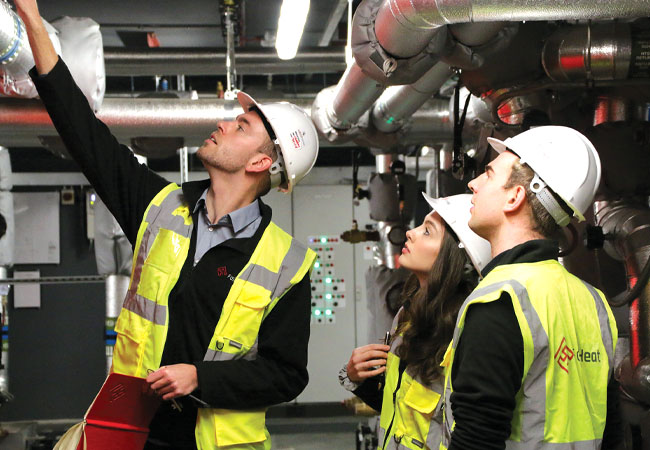
Assurance schemes would assess whether heat networks meet technical standards at design and build
The government is banking on heat networks to help the UK meet its 2050 carbon-reduction targets. In 2015, the Committee on Climate Change estimated that around 18% of the country’s heat will need to come from heat networks by 2050 if it is to meet its carbon targets cost-effectively. According to the Department for Business, Energy and Industrial Strategy (BEIS), £16bn of capital investment is likely to be needed to deliver such growth.
In 2017, with the industry set for rapid growth, the Competition and Markets Authority (CMA)recommended that the gas and electricity regulator, Ofgem, be given powers to regulate domestic heat networks. In February this year, BEIS launched a consultation for a regulatory framework that would give Ofgem oversight and enforcement powers across quality of service and pricing for domestic heat network consumers.
The consultation, Heat networks: building a market framework, proposes mandatory regulation of new heat networks and urges developers to join the Heat Trust, an independent consumer-protection scheme for heat network customers. The trust aims to ensure a minimum standard of quality and a level of protection for consumers equal to other energy customers. Scheme rules include a guaranteed performance standard for temperature, continuity of service and reporting faults. Heat interface units (HIUs) must also be maintained regularly, and suppliers signed up to the Heat Trust can be penalised if standards are not met.
‘Heat networks are maturing and becoming a central feature for the decarbonisation of heat’ says Gareth Jones, managing director at heat network specialist FairHeat. ‘This is apparent in increasing consumer protection, better technical standards – through the ADE-CIBSE Heat Networks Code of Practice – and proposed certification.’
Jones believes it is a pivotal moment for heat networks, because of the move away from gas-fired CHP energy source towards heat pumps, which has huge implications for the design of heat networks. ‘There needs to be a significant change in the way people design dwellings and systems. We need lower temperatures, which will increase the performance for heat pumps and increase the number of heat pumps that can be used,’ he says.
Regulating heat networks
The BEIS consultation looked at options for ensuring heat networks are designed, installed and operated to robust technical standards, and concluded that there should be some form of mandatory assurance schemes. ‘We know that, as the market builds, some heat networks have struggled to keep up standards in line with the rest of the sector, leading to less effective and poorer performing networks,’ says the report. ‘It is important to address this gap, both to improve the experience of consumers on poorer performing networks and to address the negative impact on the sector’s overarching reputation.’
The consultation states that assurance schemes would assess whether new heat networks had met technical standards required at design and build. It would consider whether large extensions to existing networks could be covered by the assurance scheme and whether operational requirements should be applied to existing sites.
A body such as the UK’s National Accreditation Body could have responsibility for monitoring organisations offering assurance and certification, says the CMA report, which advises organisations to join the Heat Trust to prepare themselves for future standards.
Lowering temperatures
With the decarbonisation of electricity, heat networks are being designed with heat pumps as the energy source, rather than gas-fired CHP. For heat pumps to be truly effective, says Jones, the flow and return temperatures should be lower than for a traditional CHP district network.
Heat pumps are affected by changes in temperatures, both in terms of the efficiency of the refrigeration cycle and the system complexity required to reach high temperatures from cold sources. ‘The coefficient of performance of heat pumps drops quite dramatically at higher temperatures; 5K can make a really big difference,’ says Jones. A review of three heat pump manufacturers, for example, showed an increase in seasonal coefficient of performance of 13%-21% when generating and distributing at 60°C as opposed to 65°C.

These Telford Homes apartments near London Docklands had acceptance testing
Where heating systems serve DHW and space heating, it will be the DHW supply temperature that defines system temperatures, as the space heating can be a lower temperature. So, a 5K reduction in DHW allows a 5K reduction in generation and distribution temperatures.
One barrier to lower temperatures has recently been overcome after the HSE clarified that HIUs with instantaneous hot water generation are deemed a low legionella risk. Heating systems with hot-water storage have typically had to maintain water at a high enough temperature to prevent the growth of legionella bacteria. However, this is not necessary for low-volume systems where, for example, hot water is supplied instantaneously through a heat exchanger. The HSE says that, under HSG274, Part 2, HIUs should be able to achieve a peak temperature of 50°C to 60°C.
Jones says that network temperatures should be 55°C at the HIU, with 50°C from the HIU to the tap. Many designers have used a 55°C minimum to the tap. This requires a minimum 60°C network temperature.
Faster hot water
The new version of CP1: Heat Networks: Code of Practice for the UK will include far more performance metrics and introduces the concept of acceptance testing. Acceptance testing allows validation of whether heat networks meet specified performance requirements and, as such, is well aligned with the move toward technical certification, as proposed by BEIS. Effectively, acceptance testing will be one of the core mechanisms for any future heat network assurance scheme, says Jones.
‘Our experience is that acceptance testing has a significant positive impact on network performance, with many networks performing better than design because of rigorous commissioning’ he adds.
Telford Homes is using acceptance testing to check its heat networks before handover (see ‘Site test’, CIBSE Journal, August 2018), and now also uses FairHeat to test the design, installation and commissioning. (See panel, ‘Testing every home’.)
Jones says the experience of acceptance testing out in the field will form the basis of an assurance scheme that aims to make sure developers build low carbon heat networks that offer comfort for consumers without the expense.
Testing every home
‘A consultant is like a GP,’ says Chris Savoy, head of services at Telford Homes. ‘They know a lot about heat networks, but they’re not specialists.’
Telford Homes has been testing all of its new dwellings on heat networks to ensure that performance is in line with the design intention. It has been using FairHeat to check consultant designs for heat networks for three years, and now uses the specialist to carry out checks at design, installation and commissioning stage. It also uses the specialist to ensure water quality and that the BMS controls are implemented properly.
Savoy says checks allow him to identify competent designers and contractors, which helps him select the supply chain. ‘The good ones are those that are prepared to be educated and follow British Standards and the ADE CIBSE Heat Network Code of Practice,’ he says.
The focus for Savoy is now on gathering performance evidence – including water quality – from the first year of operation to ensure that the maintenance contractor is running the system properly. ‘You have to have evidence. You have to prove performance,’ he says.
